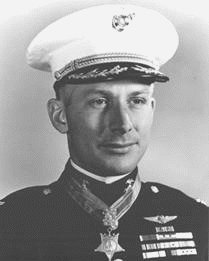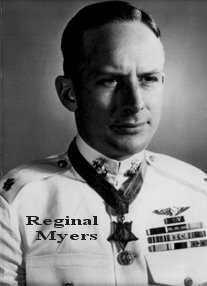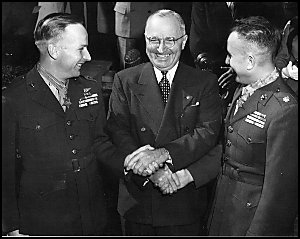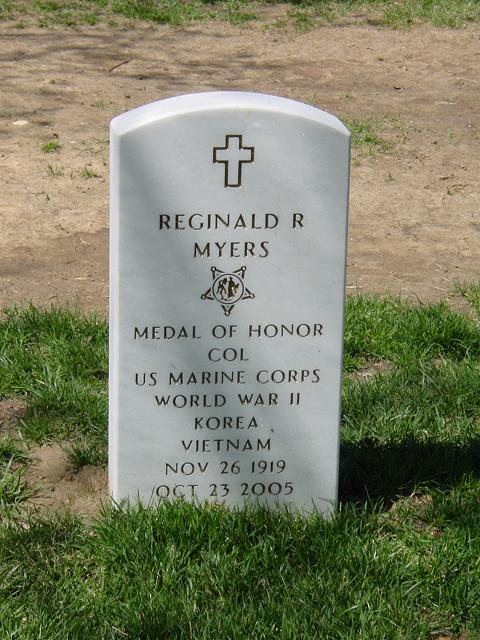Major Reginald R. Myers
United States Marine Corps
For conspicuous gallantry and intrepidity at the risk of his life above and beyond the call of duty as Executive Officer of the Third Battalion, First Marines, First Marine Division (Reinforced), in action against enemy aggressor forces in Korea on 29 November 1950.
Assuming command of a composite unit of Army and Marine service and headquarters elements totaling approximately 250 men, during a critical stage in the vital defense of the strategically important military base at Hagaru-ri, Major Myers immediately initiated a determined and aggressive counterattack against a well entrenched and clearly concealed enemy force numbering and estimated 4,000.
Severely handicapped by lack of trained personnel and experienced leaders in his valiant efforts to regain maximum ground prior to daylight, he persisted in constantly exposing himself to intense, accurate and sustained hostile fire in order to direct and supervise the employment of his men and to encourage and spur them on in pressing the attack. Inexorably moving forward up the steep, snow-covered slope with his depleted group in the face of apparently insurmountable odds, he concurrently directed artillery and mortar fire with superb skill and, although losing 170 of his men during fourteen hours of raging combat in sub-zero temperatures, continued to reorganize his unit and spearheaded the attack which resulted in 600 enemy killed and 500 wounded.
By his exceptional and valorous leadership throughout, Major Myers contributed directly to the success of his unit in restoring the perimeter. His resolute spirit of self-sacrifice and unfaltering devotion to duty enhance and sustain the highest traditions of the United States Naval Service.
Harry S. Truman
President of the United States
Colonel Reginald Myers, USMC Retired, was awarded the Congressional Medal of Honor while serving as Executive Officer, 3rd Battalion, 1st Marines, in the vicinity of HAGARU-RI, KOREA, November 29, 1950, while commanding a group of 80 men who were stragglers and missing from other units. Major Myers’ makeshift unit successfully denied the Chinese Communists the possession of EAST HILL, which dominated the key crossroads in the withdrawal—attack in another direction—by US Marines and Army units from the Chosin Reservoir.
When Major Myers unit was relieved by another they had killed six hundred enemy troops and wounded another five hundred the “old fashioned way:” BOOTS ON THE FROZEN GROUND!
Major Myers was wounded in action some months later and evacuated from the theater of war. He retired as a Colonel, USMC, and lives in Florida. Indicative of the ferocity of combat conditions, the commanding officer of the unit that relieved Major Myers was also awarded the MOH after finally securing EAST HILL: Captain Carl Sitter, USMC.
Captain Sitter retired as a Colonel and became a lay minister in his church. He died April 4, 2000, in Richmond, Virginia.
The bell inside the Jupiter Elks, Florida, Lodge on Monday evening chimed 11 times in memory of a local hero who slipped out of this world in the same quiet way he lived in it.
Reginald R. Myers, a Congressional Medal of Honor recipient and a Jupiter resident, died Sunday, October 23, 2005, at 11 a.m. — a patriotic time of day that his wife of 62 years, Margaret, remembers well.
President Harry Truman presents the Medal of Honor to Marines Reginald Myers, left,
and Carl Sitter on Octobet. 29, 1951, for “conspicuous gallantry nd intrepidity at the risk
of (their lives) above and beyond the call of duty.”
“That was the time we used to have (Veterans) Day service at schools,” said Margaret Myers, 85. “Everything stopped, and we stood at attention.”
Veterans Day marks the anniversary of the 1918 end of World War I. It was on “the eleventh hour of the eleventh day of the eleventh month” that the cessation of hostilities took effect.
The Treaty of Versailles ending the “war to end all wars” was later signed, and Americans for years marked Veterans Day with a moment of silence at 11 a.m.
Myers, a Boise, Idaho native, had participated in World War II invasions of Guadalcanal, the Marshall Islands and Okinawa and, by 1950, was a major serving in Korean War with the 3rd Battalion 1st Marines Division.
Assigned to defend a mount overlooking an American base at Hagaru-ri at a time when Chinese forces outnumbered those of the United States by thousands, he gathered some 250 dispirited soldiers — cooks, clerks and mechanics included — and embarked upon a steep nighttime ascent of the icy East Hill. The Chinese fired on them with machine guns as they climbed in tempertures that fell to 23 degrees below zero.
Only 80 Marines, including Myers, reached the summit where they fought an arduous, and ultimately successful, battle.
After being wounded in action, Myers shipped back to the U.S. in 1951.
For his courage at East Hill, President Harry Truman was to present him the Medal of Honor — the highest award for battlefield valor that can be bestowed upon an American soldier.
Only 3,460 Medals of Honor have been awarded during its 142-year history. A mere 120 Medal of Honor winners still are alive.
“Most people didn’t know my father was a Medal of Honor (recipient),” said Myers’ daughter, Susan Avery, of Superior, Mt. “He wouldn’t talk about it unless he was asked.”
“He was a common man with uncommon virtues,” said his son Scott Myers, of Annandale, Virginia.
Reginald Myers, over the course of his miltary career, was awarded an additional 14 medals, including a Legion of Merit, Purple Heart and Bronze Star.
In 1993, he and Margaret in 1993 moved to Jupiter, where the gregarious, hard-working veteran and family man — a “Marine’s Marine” — enjoyed gardening, boating, action and sci-fi movies, genealogy research and leisurely drives along A1A.
The couple had met Queen Elizabeth II and attended the presidential inaugurations for Dwight Eisenhower, Jimmy Carter, Ronald Regan, Bill Clinton and both George Bushes.
Here in North County, Myers befriended fellow Marine Ed Resnik, a Tequesta Village councilman, who took him to military meetings and social functions — insisting that he wear the medal.
“Other service people know what men who’ve put their lives on the line have gone through,” said Avery. “I guess we go about our lives and don’t really think about what servicemen are doing for us, that they’re risking their lives.”
Reginald Myers two years ago was diagnosed with Parkinson’s Disease and in September, at age 85, suffered a massive stroke. About 100 attended a Monday evening memorial service at the Jupiter Elks Lodge 2469. Many had met him through Resnik.
“We are here honoring a man who had (at least) one moment in his life where he went above and beyond the call of duty,” said Palm Beach Martin Military Officers Association Past President Steve Dukkony. “He represented what all of us wanted to represent … (and) he had no idea at that time that he was doing anything other than his duty.”
In addition to his wife, daughter and son, Myers leaves behind five grandchildren and a great granddaughter.
A funeral and interment service — with riderless horse — is scheduled for December 21, 2005, at Arlington National Cemetery.
The Myers family has asked that, in lieu of flowers, memorial contributions be made to the National Parkinson’s Foundation or Hospice of Palm Beach County.
24 November 2005:
Reginald Myers, a Marine Corps Colonel who received the Medal of Honor in the Korean War for leading his vastly outnumbered force in an assault on a key position during the Battle of the Chosin Reservoir, died October 23, 2005, at a hospice in West Palm Beach, Florida, of the effects of a stroke. He had lived in Jupiter, Fla., since moving there from Annandale, Va., in 1993. He was 85.
Before Myers set foot in Korea, he was a veteran of some of the fiercest fighting in the Pacific during World War II. As a young Marine officer who rose through the ranks from Second Lieutenant to Major in less than four years, he fought at Guadalcanal, the Solomon Islands, the Marshall Islands and in the Battle of Okinawa.
He went to Korea in July 1950 as a battalion executive officer in the 1st Marine Division. He received two Bronze Stars four days apart in September, first as part of the U.S. invasion at Inchon and later for rescuing two wounded Marines.
In late November 1950, Myers’ assignment was to recapture a high point of land near the Chosin Reservoir called East Hill. An Army unit trying to defend the hill had been driven from its position by Communist Chinese troops. Ordered to retake the hill to secure a safe evacuation for the outmanned United Nations forces, Myers did not have a standard fighting force to command.
“I had no Marine rifle company or unit of any type in my area,” he told the Idaho Military Historical Society in a 2001 interview. “So, as I walked toward East Hill, I formed my own combat element from support Marines, such as cooks, truck drivers, maintenance personnel and administrative personnel, recruiting Marines along the way. I ended up with about 50 hard-charging Marines that were raring to go and anxious to get into the fight, and the 200 soldiers at the bottom of East Hill – 250 overall.”
With that small, improvised unit, Myers led an attack against an entrenched force of 4,000 Chinese troops Nov. 29, 1950. The conditions could not have been more forbidding: He launched his charge at night, up a steep, snow-covered hill in biting wind and a temperature of 23 degrees below zero.
Only 80 of Myers’ 250 troops reached the summit with him, but they were able to hold the hill in spite of steady machine-gun fire and repeated Chinese assaults. According to his Medal of Honor citation, Myers “persisted in constantly exposing himself to intense, accurate, and sustained hostile fire in order to direct and supervise the employment of his men and to encourage and spur them on in pressing the attack.”
He directed artillery and mortar fire and set up emplacements to defend the hill from Chinese efforts to recapture it. The intense fighting lasted 14 hours before reinforcements arrived. Myers’ beleaguered force killed more than 600 Chinese soldiers and wounded 500.
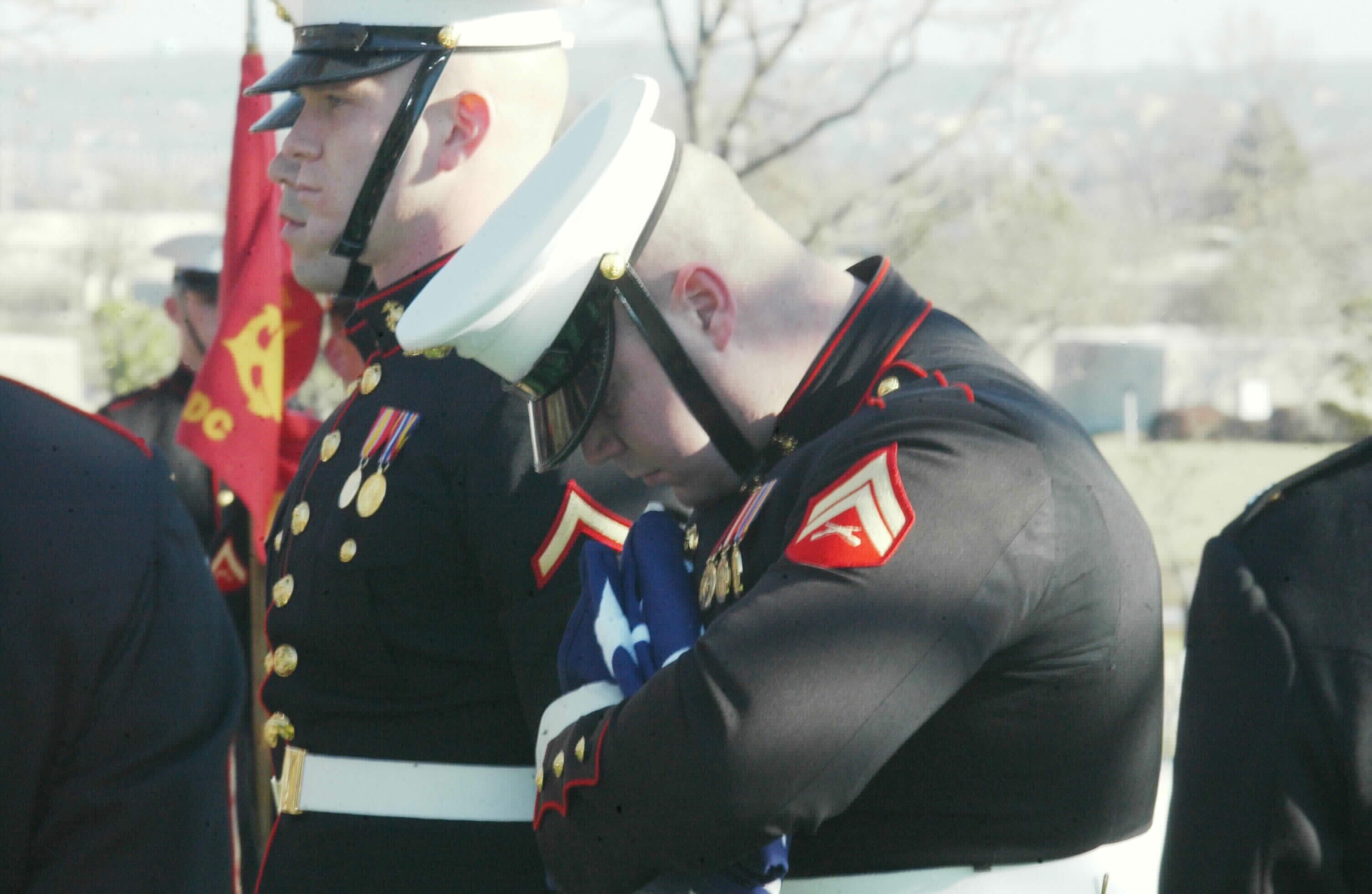
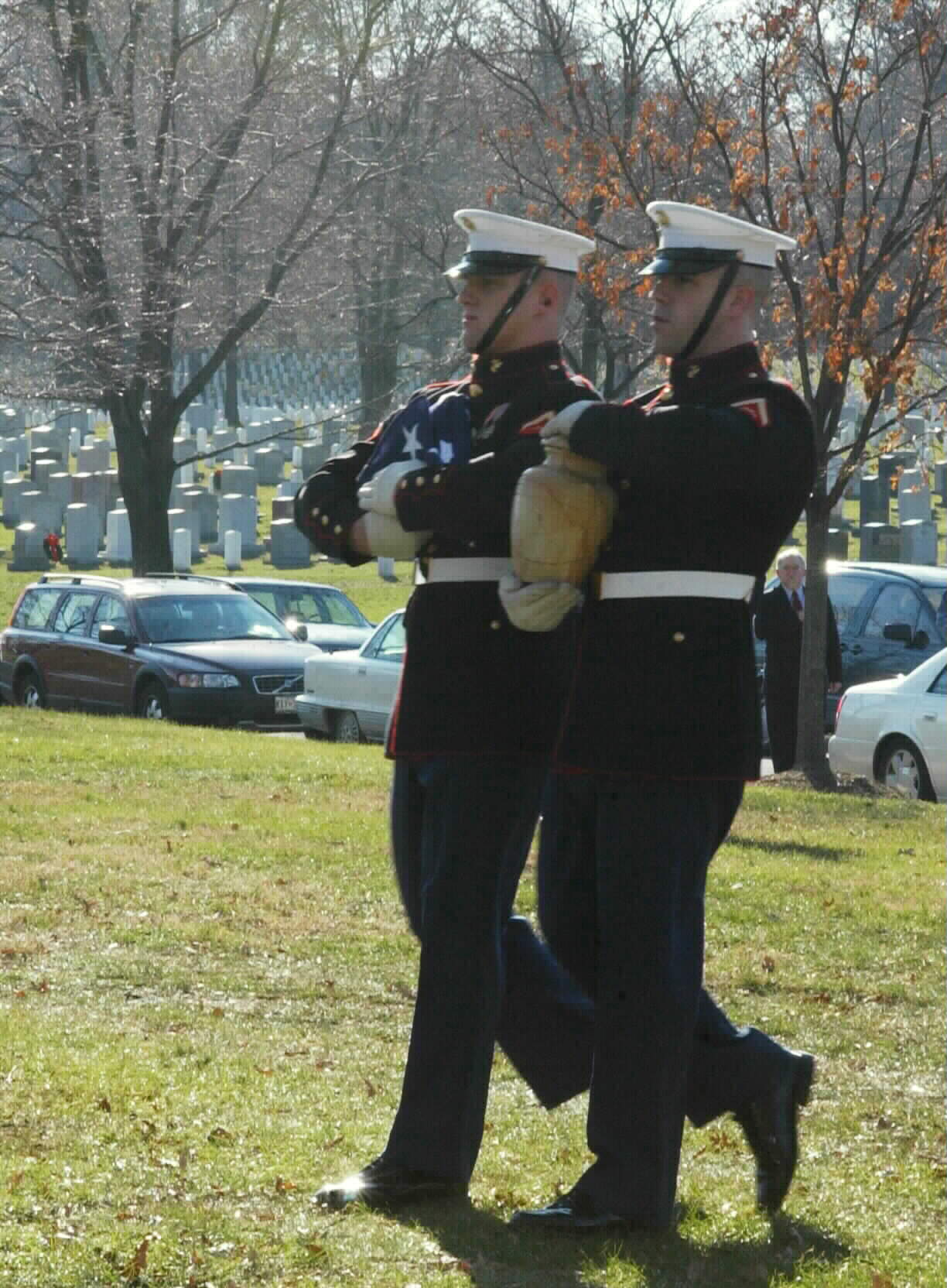
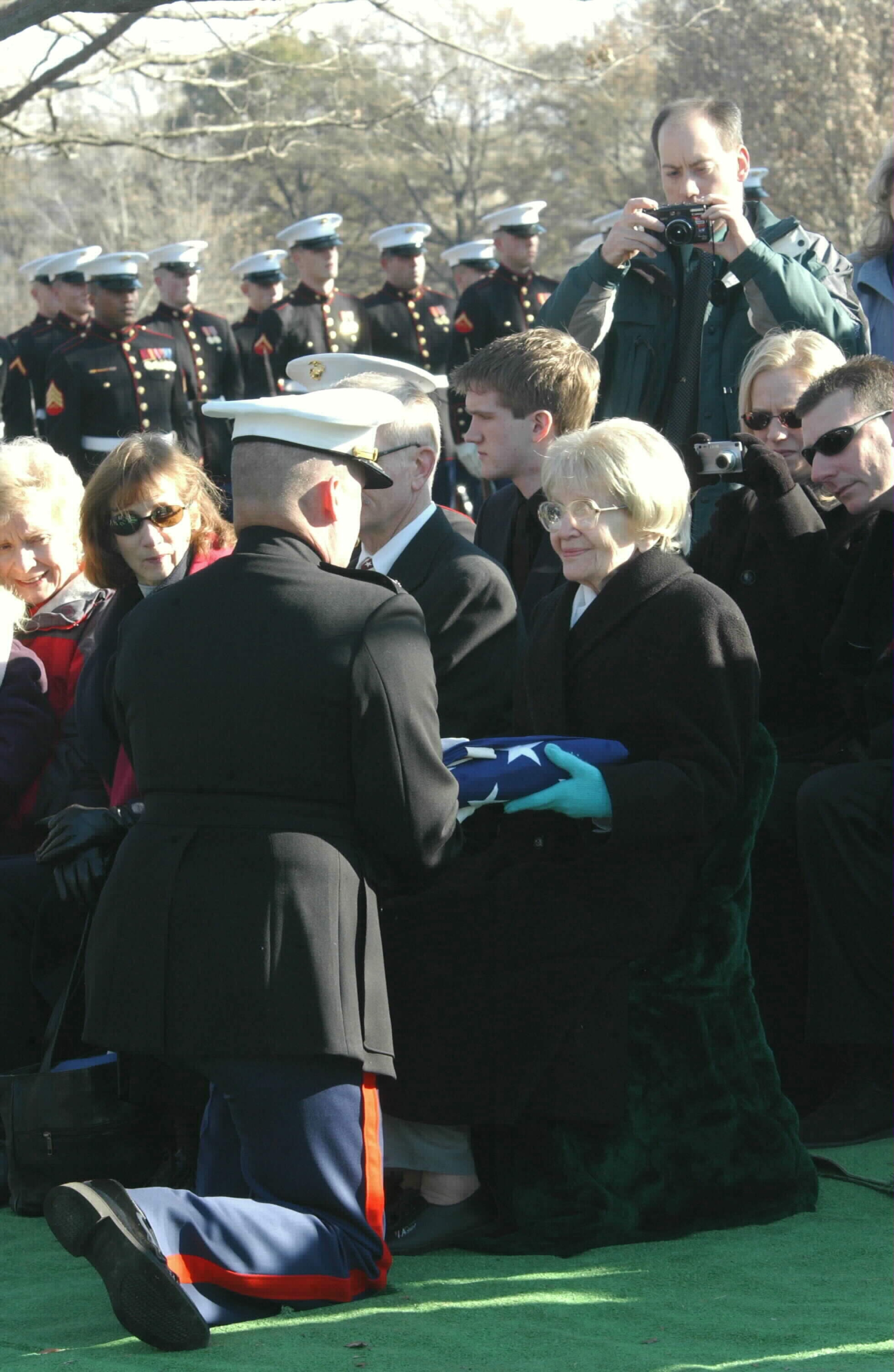
Michael Robert Patterson was born in Arlington and is the son of a former officer of the US Army. So it was no wonder that sooner or later his interests drew him to American history and especially to American military history. Many of his articles can be found on renowned portals like the New York Times, Washingtonpost or Wikipedia.
Reviewed by: Michael Howard

